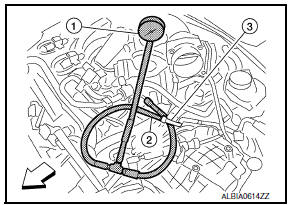Nissan Maxima Service and Repair Manual: Fuel pressure
Inspection
FUEL PRESSURE RELEASE
With CONSULT
- Turn ignition switch ON.
- Perform "FUEL PRESSURE RELEASE" in "WORK SUPPORT" mode with CONSULT.
- Start engine.
- After engine stalls, crank it two or three times to release all fuel pressure.
- Turn ignition switch OFF.
Without CONSULT
- Remove fuel pump fuse located in IPDM E/R. Refer to FL-6, "Removal and Installation".
- Start engine.
- After engine stalls, crank it two or three times to release all fuel pressure.
- Turn ignition switch OFF.
- Reinstall fuel pump fuse after servicing fuel system.
FUEL PRESSURE CHECK
CAUTION: Before disconnecting fuel line, release fuel pressure from fuel line to eliminate danger.
NOTE:
- Prepare pans or saucers under the disconnected fuel line because the fuel may spill out. The fuel pressure cannot be completely released because A35 models do not have fuel return system.
- Be careful not to scratch or get the fuel hose connection area dirty when servicing, so that the quick connector o-ring maintains seal ability.
- Use Fuel Pressure Gauge Kit [SST (J-44321)] and Fuel Pressure Adapter [SST (J-44321-6)] to check fuel pressure.
- Release fuel pressure to zero.
- Remove fuel hose using Quick Connector Release [SST (J-45488)]. Refer to FL-10, "Exploded View".
- Do not twist or kink fuel hose because it is plastic hose.
- Do not remove fuel hose (3) from quick connector.
- Keep fuel hose connections clean.
- Install Fuel Pressure Adapter [SST (J-44321-6)] (2) and Fuel Pressure Gauge kit [SST (J44321)] (1) as shown in figure.
- Do not distort or bend fuel rail tube when installing fuel pressure gauge adapter.
- When reconnecting fuel hose, check the original fuel hose for damage and abnormality.
- Turn ignition switch ON (reactivate fuel pump) and check for fuel leakage.
- Start engine and check for fuel leakage.
- Read the indication of fuel pressure gauge kit [SST (J-44321)].
- During fuel pressure check, check for fuel leakage from fuel connection every 3 minutes.

At idling : Approximately 350 kPa (3.57 kg/cm2, 51 psi)
- If result is unsatisfactory, go to next step.
- Check the following.
- Fuel hoses and fuel tubes for clogging
- Fuel filter for clogging
- Fuel pump
- Fuel pressure regulator for clogging
- If OK, replace fuel pressure regulator.
If NG, repair or replace malfunctioning part.
- Before disconnecting Fuel Pressure Gauge kit [SST (J-44321)] and Fuel Pressure Adapter [SST (J- 44321-6)], release fuel pressure to zero.
 Evap leak check
Evap leak check
Inspection
CAUTION:
Never use compressed air or a high pressure pump.
Never exceed 4.12 kPa (0.042 kg/cm2, 0.6 psi) of pressure in
EVAP system.
NOTE:
Do not start en ...
Other materials:
Loose fuel cap warning
The LOOSE FUEL CAP warning appears in the
vehicle information display when the fuel-filler
cap is not tightened correctly after the vehicle has
been refueled. It may take a few driving trips for
the message to be displayed. To turn off the
warning, perform the following:
1. Remove and inst ...
Parking brake shoe
Exploded View
Back plate
Parking brake shoe (front)
Adjuster
Adjuster spring
Return spring
Anti-rattle spring
Retainer
Anti-rattle pin
Toggle lever
Parking brake shoe (rear)
Front
Apply PBC (Poly Butyl Cuprysil)
grease or silicone based grease
Removal ...
Power supply and ground circuit
BCM
BCM : Diagnosis Proce
1. CHECK FUSE AND FUSIBLE LINK
Check if the following BCM fuses or fusible link are blow
2. CHECK POWER SUPPLY CIRCUIT
Turn ignition switch OFF.
Disconnect BCM.
Check voltage between BCM harness connector and ground.
3. CHECK GROUND CIRCUIT
Check con ...
Nissan Maxima Owners Manual
- Illustrated table of contents
- Safety-Seats, seat belts and supplemental restraint system
- Instruments and controls
- Pre-driving checks and adjustments
- Monitor, climate, audio, phone and voice recognition systems
- Starting and driving
- In case of emergency
- Appearance and care
- Do-it-yourself
- Maintenance and schedules
- Technical and consumer information
Nissan Maxima Service and Repair Manual
0.0182

